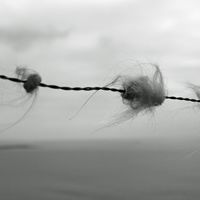Here & Elsewhere: ‘The View from the Horizon’
‘After over thrity years on the edge of Europe, developing a distinctive apporoach to the writing of place focused on the ‘mysterious hinterlands west and south of Galway, Tim Robinson’s attention is turning to other places, some of which he evokes in ‘Elsewhere’. In these three essays on Connemara and Elsewhere, ‘he is already ranging far from its shores – to prisons and ditches ion France, into weird towers looming over urban warrens and along a reverberation set up between boyhood memories of his grandparents’ village in north Wales and the lecture halls of Cambridge. Even with these apparent departures from his Irish scenes, though continuities remain.’
John Elder, ‘Introduction: unfolding the map,’ Connemara and Elsewhere, p. 19
'Though I have probably taken more steps about and on my three western marches than most of their born inhabitants, I have not put down roots in any of them. Roots are tethers…'
Setting foot on the shores of Connemara, 1996, p. 212
'Place de la Contrescarpe is small and frequently crowded. On three of its sides are restaurants and bars fronted by ranks of chairs and tables on the pavements, under red canopies. The centre of the Place is marked by a little fountain surrounded by a rather sparse grove of young trees, within a circle of cast iron pots linked by loops of chain. The space immediately within the chained circle is the preserve of two street-dwellers, stubby men wearing layers of clothing made grey by weather. One of them has his hair in dreadlocks. They lie stretched out on bits of cardboard, or on the bare cobbles. Occasionally they exchange a few brief curses but otherwise seem to have little to do with each other. My passing glimpses of their tedious and comfortless existences tell me little about how they live, where they find food, where they spend their nights. It does not seem that God tempers the wind to them. There is also an elderly lady in a long-greyish overcoat who circulates in the square accosting passers-by. Her speech is a shouted whisper like a sudden venting of compressed air. Once she materialized unnoticed behind M and addressed her with an explosive hiss of ‘Madame!’ that frightened her into jumping from one side of me to the other as if fleeing a curse – a most unhabitual reflex for her, normally so open-hearted.
Five narrow streets diverge from the Place, two of them climbing northwards and westwards, two falling eastwards towards the Jardin des Plantes, and the other, Rue Mouffetard, dropping steeply away to the south. This street is the spine of the area indicated by Debord. It is narrow, cobbled and picturesque, but not too self-consciously so. There are queues outside certain pâtisseries, dashing young men preside over smoking hotplates in crêperies no bigger than cupboards, the jewellers’ displays and vegetable stalls are exquisitely colour-coordinated, scores of identical cane chairs press together as closely as possible outside restaurants around corners off the street. In the Christmas season a web of countless tiny lights that might have been scissored out of the Milky Way is suspended above the street from end to end. Among the branches of the trees in the Place more lights cleverly imitate the soft fall of big snowflakes. Everything is enchanted; even one of the street-dwellers lying by the fountain as if fallen to the very foot of the contrescarpe of life, oblivious to the busy shoppers stepping around and over him, is parcelled up in silver foil, a Christmas present that nobody wants.'
‘Contrescarpe’, Connemara and Elsewhere, p. 141-2
'This imagery of steps, walks, mazes, webs is not entirely something I have freely chosen to elaborate, and it could become a knot-garden I have to cut my way out of. Perhaps I need to quit these worn ways and trodden shores, to test these ideas elsewhere, to travel in search of that impossibility, the view from the horizon.'
The View from the Horizon, 1997, p. 43
View 'The View from the Horizon' in library catalogue
'Already my mind is turning elsewhere, stylistically as well as geographically. Here three brief forays into this new terrain. Each relies on an atom of autobiography to spark it off, and thereafter explores a possibility of formal invention.'
Preamble to the three essays in ‘Elsewhere,’ in Connemara and Elsewhere, p. 128
'With all their concreteness, precision and richness of perception, Tim Robinson’s books and maps from Connemara were always about transience. They delineated traces left in the heart by the arisings and vanishings of beauty. Even in the initial sentence of his first essay about this peninsula, the 1990 ‘Space, time and Connemara,’ he was already saying goodbye: ‘Connemara – the name drifts across the mind like cloud shadows on a mountainside, or expands and fades like circles on a lake after a trout has risen.'
John Elder, ‘Introduction: unfolding the map,’ Connemara and Elsewhere, p. 23




